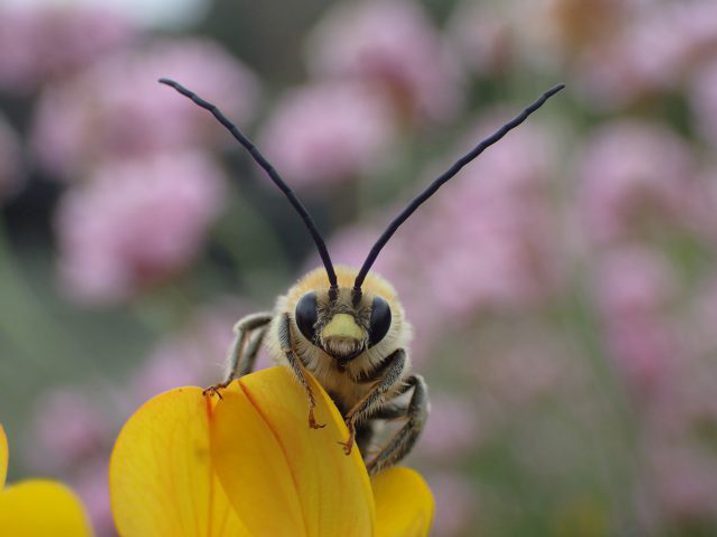In a nutshell...
Funding: Starting at £50,000
Length: Negotiable, funding dependent
Location: South Devon National Landscape
Aim: To expand and enhance the ongoing Buglife partnership project across South Devon's coast.
Opportunities: Corporate immersion days.
*subject to additional management fees

Long-horned mining bee (c) John Walters
The opportunity
The silent extinction of our insects could be one of the greatest threats to our health and livelihoods, and yet few people know about it.
Vital to balanced ecosystems, they pollinate our plants and crops, recycle nutrients, break down plant matter, enrich the soil, and feed other crucial species.
In fact, it’s estimated that the value of insect pollination to the world’s agriculture is around $235-577 billion every year.
So what’s happening to our invertebrates?
Human activities play a major role in the decrease of populations for a number of reasons from insecticides to habitat loss more generally.
Here in the UK, we are relatively unique in that we have quite a lot of data on our insect populations thanks to long-term recording schemes, natural history collections, citizen science, and an engaged research community.
As a result, we can make informed assessments about the state of our insect populations and what they need to recover.
Of the 2,430 British insect species assessed by Natural England, 55 are extinct and 286 (11%) are threatened.
The compounding impact of any further insect loss is unprecedented.
Birds rely on insects for their food, and so do we...

Meloe brevicollis (c) John Walters
The project
Life on the Edge is a project led by the South Devon National Landscape in partnership with Buglife, National Trust, Torbay Coast and Countryside Trust, and the South West Coast Path Assocation.
This team of specialist organisations is on a mission to reverse the decline of some of England’s rarest and most threatened insect species.
Life on the Edge aims to save species; giving them a safer long-term future by expanding and reconnecting the traditional coastal landscapes on which they depend.
Restoring wildflower-rich cliff tops and highway verges, carefully managing scrub mosaics, strategic hedgerow connections, and more wildlife-friendly parks, churchyards, school grounds and private gardens.
- Buglife
The project area covers the whole of the "B-Line" along the South Devon coast (the pathway that pollinators generally take in that particular place), which is 12,260ha.
The team has identified five project hotspots where they will create or restore species-rich habitats specifically designed to support their target invertebrate species.
They will also work with landowners in between those sites to connect the dots and restore their patches of land in-between.
This landscape-scale project is unique in its collaborative, puzzle-piece approach, facilitating a healthy coastal corridor for our vital wildlife to move and survive.
This exciting project is underway, but it needs your help.
In order to expand its wildflower enhancement piece, the team is looking to secure extra funding. This is your chance to join an established project and strong partnership that is prioritising one of the most under resourced, yet valuable conservation targets – our invertebrates.
Chat to the team about sponsoring a species, its habitat, and this vital coastal work today.
Key outputs
These outputs are being developed and delivered by the partnership as we speak.
This means that additional funding from a corporate partner would allow us to unlock the next level of nature recovery and connectivity, and you can be part of choosing those measurable outputs.
- The expansion of an exemplar nature restoration project in a stunning location.
- Halt and reverse the decline in some of England’s rarest species.
- Create and restore vital habitats like wildflower-rich cliff tops and highway verges, scrub mosaics, hedgerow connections, parks, churchyards, school grounds, and gardens.
- Landowner and community engagement to raise aware of the project and earn support and trust.
- Up to 12,260ha of healthy and connected B-Line.
Check out some of the insect species the teams are working to protect.
30 threatened species, 1 project to save them
Here's the list of species that Life on the Edge is working hard to save:
- Hemlock Water-dropwort Bee (Andrena ampla)
- Hawksbeard Mining Bee (Andrena fulvago)
- Carrot Mining Bee (Andrena nitidiuscula)
- Black Mining Bee (Andrena pillipes)
- Hornet Robberfly (Asilus crabroniformis)
- Six-belted Clearwing (Bembecia ichneumoniformis)
- Brown-banded Carder Bee (Bombus humilis)
- Dotted Bee-fly (Bombylius discolor)
- Moon Spider (Callilepis nocturna)
- Zipperback Hoverfly (Chrysotoxum elegans)
- Goldilocks Aster Moth (Coleophora linosyridella)
- Ridge-saddled Spider Wasp (Cryptocheilus notatus)
- Cranefly (Diacranomyia goritiensis)
- Long-horned Bee (Eucera longicornis)
- Mason wasp (Euodynerus quadrifasciatus)
- Grayling (Hipparchia Semele)
- Orange-footed Furrow Bee (Lasioglossum xanthopus)
- Silvery Leafcutter Bee (Megachile leachella)
- Short-necked Oil Beetle (Meloe brevicollis)
- Mediterranean Oil Beetle (Meloe mediterraneus)
- Black Oil Beetle (Meloe proscarabaeus)
- Devon Red-legged Robberfly (Neomochtherus pallipes)
- Six-banded Nomad Bee (Nomada sexfasciata)
- Grey Bush Cricket (Platycleis albopunctata)
- Silver-studded Blue (Plebejus argus)
- Red-tailed Blood Bee (Sphecodes rubicundus)
- Banded Dark Bee (Stelis punctulatissima)
- Thrift Clearwing (Synansphecia muscaeformis)
- Great Green Bush Cricket (Tettigonia viridissima)
- Glow Worm (Lampyris noctiluca)

